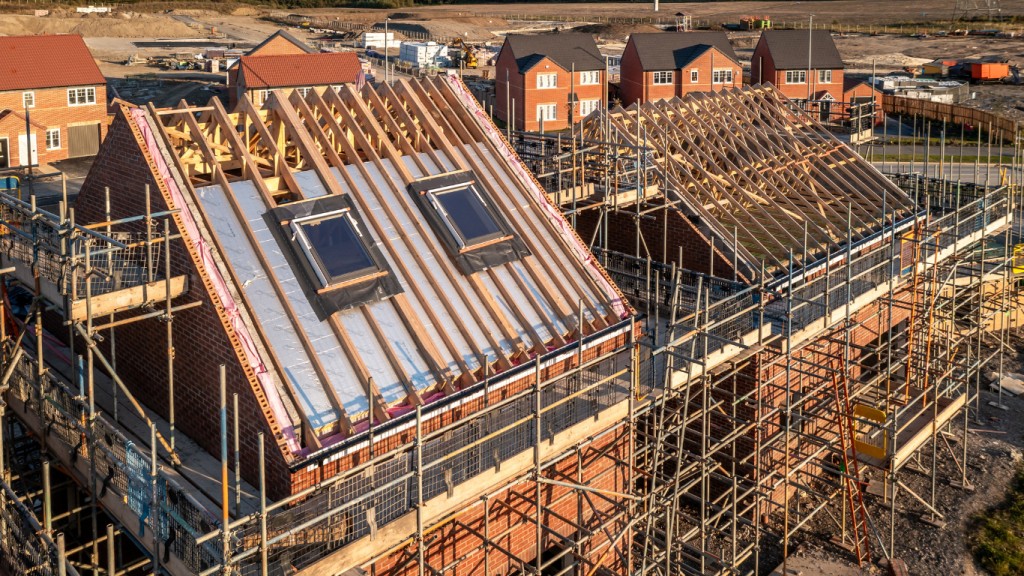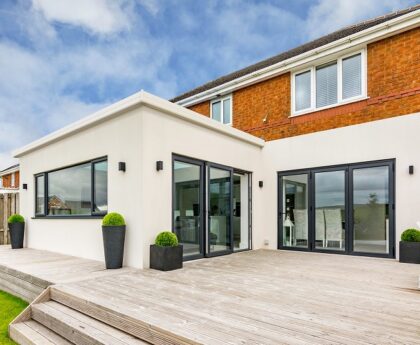For millennia, wood has served as a fundamental building material across civilisations. Archaeological evidence reveals humans have utilised this natural resource for over 10,000 years. In the United Kingdom, this tradition continues with remarkable examples like Westminster Hall in Parliament, which boasts the largest medieval timber roof in Northern Europe.
Today, this ancient practice experiences a significant resurgence as developers seek sustainable alternatives. The growing interest stems from pressing environmental concerns and housing demands across the UK. Modern building techniques have transformed traditional methods into innovative solutions for contemporary challenges.
This article provides a comprehensive analysis of timber’s role in modern UK projects. It explores the material’s environmental benefits, economic considerations, and practical applications. The focus remains on balanced assessment of both opportunities and limitations within the current building landscape.
The resurgence reflects broader shifts toward eco-conscious development strategies. Policymakers, developers, and the public increasingly recognise the value of materials that reduce environmental impact while maintaining structural integrity.
Key Takeaways
- Wood has been used as a primary building material for over ten thousand years
- Westminster Hall demonstrates the remarkable durability of timber structures
- Modern techniques have revitalised traditional building approaches
- Sustainable materials address both environmental concerns and housing needs
- The UK building sector shows growing interest in eco-friendly solutions
- This analysis covers technical, economic, and environmental aspects
- Timber construction represents a blend of historical practice and innovation
Overview of Sustainable Timber Construction in the UK
England and Scotland demonstrate markedly different approaches to incorporating wood in residential development. This divergence highlights significant opportunities for growth in sustainable building practices across Britain.
Statistics reveal a dramatic contrast. Only 9% of new homes in England used timber frames in 2019. Meanwhile, Scotland achieved a remarkable 92% adoption rate for the same building method.
The UK government aims to build 1.5 million homes during the current Parliament. This massive housing programme creates unprecedented potential for expanding wood-based construction. Such expansion could simultaneously address housing shortages while creating green employment opportunities.
Official policy supports this direction. The Climate Change Committee recommends new policies to increase wood use in building. This aligns with the government’s timber in construction roadmap for 2025.
Public opinion strongly favours this approach. A 2020 UK Citizens Assembly found 82% support for using wood in building to meet net zero commitments. This demonstrates clear social acceptance for sustainable material choices.
The industry stands ready for rapid scaling. With proper support, wood-based building can deliver significant economic and environmental benefits across England and the wider UK.
Historical Perspective and Traditional Methods
The evolution of wood-based structural systems in Britain showcases remarkable craftsmanship and engineering ingenuity. These traditional approaches continue to influence contemporary building practices across the United Kingdom.
Half-Timbering Principles
Half-timbering represents a distinctive approach where load-bearing frames create visible panel spaces. Artisans filled these spaces with non-structural materials like wattle and daub.
This method produced the characteristic aesthetic seen in historic town centres throughout Britain. Germany remains particularly renowned for this architectural style, though the UK maintains its own rich heritage.
Cruck Framing Techniques
Cruck framing utilises pairs of curved timbers called blades that form supportive bents. These extend from foundation to ridge, creating a robust structural system.
Over 4,000 cruck frame buildings survive in the UK today. Variations include true crucks, base crucks, and raised crucks, each serving different architectural needs.
| Traditional Method | Key Characteristics | Primary Tools Used | Historical Prevalence in UK |
|---|---|---|---|
| Half-Timbering | Load-bearing frame with infill panels | Broadaxes, adzes | Widespread in medieval urban centres |
| Cruck Framing | Curved timber blades forming bents | Draw knives, wooden pegs | Over 4,000 recorded structures |
| Post-and-Beam | Squared timbers with precise joints | Mortise and tenon techniques | Common in rural and agricultural buildings |
These historical methods demonstrate sophisticated joinery without metal fasteners. Large wooden pegs secured mortise and tenon joints, creating durable structures that have endured for centuries.
Pros of Timber Construction
The case for adopting timber-based building methods rests on compelling evidence across environmental and economic dimensions. These advantages make wood an increasingly attractive choice for modern development projects throughout the United Kingdom.
Environmental Benefits
Wood-based structures offer significant ecological advantages. They can reduce embodied carbon emissions by 20% to 60% compared to conventional materials.
Timber acts as a natural carbon store, locking away atmospheric carbon throughout its lifespan. Homes using wooden frames demonstrate approximately 50% higher carbon storage than masonry alternatives.
When sourced from responsibly managed forests, this approach supports circular resource cycles. It promotes afforestation programmes while providing renewable materials.
Economic Advantages
Pre-fabricated wooden frames enable remarkably swift assembly. Typical erection takes just 7 to 10 working days after delivery.
This accelerated timeline substantially reduces labour expenses and overall project duration. Faster completion allows interior trades to begin work sooner.
Wood’s excellent insulation properties permit thinner walls with equivalent thermal performance. This characteristic reduces material requirements and heating costs.
The expansion of timber-based building creates green employment opportunities across supply chains. It supports economic growth while advancing sustainability goals.
Cons of Timber Construction
Despite its many advantages, building with wood presents specific challenges that require careful management. Acknowledging these factors is essential for making informed decisions and ensuring project success.
Fire Safety Concerns
Combustibility is a primary consideration. However, modern engineering provides robust solutions.
Properly designed structures incorporate fire protection measures. These include compartmentalisation and sprinkler systems. Such features allow buildings to meet stringent safety standards.
Engineered mass timber products offer predictable performance. Their outer layers char at a known rate, protecting the inner core’s integrity for a specified duration. This predictability is a key safety factor.
Maintenance and Durability Issues
Wood is susceptible to moisture, rot, and insect infestation if not protected. High-quality work and appropriate material selection are vital for longevity.
Misconceptions about maintenance requirements are common. With correct design details and protective treatments, timber structures can achieve excellent durability.
Skilled craftsmanship is non-negotiable. Poor execution can lead to issues not always seen with other materials. Ensuring the appropriate use of timber and adherence to safety standards are critical.
A lack of understanding among developers and insurers can create barriers. Overcoming this requires demonstrating that technical solutions exist for these challenges.
Understanding Timber as a Building Material
Different tree species offer distinct characteristics that determine their suitability for various construction purposes. Wood is an organic, renewable building material with natural variation in its properties depending on species, growth conditions, and processing methods.
This versatile material serves both structural and non-structural roles. Structural applications include load-bearing frames, floors, and roofs requiring specific strength characteristics. Non-structural uses encompass internal partitions, doors, windows, and decorative elements where aesthetic qualities are valued.
Softwoods like Douglas fir provide excellent strength for structural applications. Hardwoods often offer greater durability and visual appeal. A comprehensive understanding of wood as a building material includes knowledge of grading systems that classify based on strength, knot sizes, and defects.
Engineered products like plywood and oriented strand board extend wood’s versatility. The cellular structure gives it an advantageous strength-to-weight ratio. Sawmill coproducts and waste wood can be transformed into insulation materials, supporting circular economy principles.
Innovative Timber Kit Design and Modern Applications
Factory-based production represents a significant evolution in wood-based building systems. Modern approaches utilise fewer, larger wooden members typically measuring 15 to 30 centimetres. This contrasts with traditional framing that required many smaller components.
Open and closed panel systems dominate England’s structural timber applications. Complete wall sections with insulation and vapour barriers are manufactured off-site. This allows for rapid assembly on location, significantly reducing project timelines.
The development of Timber Kit Design integrates advanced engineering with natural material benefits. These solutions create high-performance building envelopes with superior thermal characteristics. A complete Timber Kit ensures precision through quality-controlled factory conditions.
Structural insulated panels (SIPs) represent another innovative method. These systems entirely enclose the timber framework within manufactured panels. Construction becomes less complex while insulation performance increases substantially.
Digital technologies like BIM and CNC machinery enable complex timber projects. These tools facilitate services integration and airtightness strategies. They help achieve demanding energy performance standards across various building types.
Contemporary applications span residential, commercial, educational, and public buildings. This demonstrates the versatility of modern timber construction methods. The approach combines efficiency with environmental responsibility.
Technical Aspects of Timber Frames
The technical foundation of timber frame systems combines centuries-old craftsmanship with contemporary engineering. This section explores the core methods that give these structures their strength and durability.
Traditional Joinery Techniques
Traditional framing relies on intricate wood-to-wood connections. The mortise and tenon joint is a classic example, where a projecting tenon fits snugly into a carved mortise cavity.
Wooden pegs secure these joints, creating remarkably strong connections without metal fasteners. Other techniques like lap joints and dovetails serve specific purposes in the overall assembly.
Diagonal bracing is a critical strategy. It prevents racking, which is the lateral movement of vertical posts under stress. This triangulation ensures the frame’s stability against wind and other forces.
Modern Engineering Methods
The 1930s saw the development of the modern timber connector method. This approach revolutionised load transfer using metal components.
Systems like split-ring connectors and toothed plates enable efficient force distribution between members. These are held together with through-bolts for enhanced strength.
Contemporary timber engineering follows strict design standards like Eurocode 5. Computer-aided design and finite element analysis allow engineers to optimise structures for safety and performance.
Since the 1960s, factory-made trussed rafter systems have become common. Sawn timber members are connected with metal plates to create efficient roof structures quickly.
Timber Construction: Pros and Cons Analysis
The suitability of any primary material is ultimately determined by its alignment with a project’s unique set of constraints and ambitions. This analysis consolidates the key advantages and challenges associated with wood-based frameworks to aid informed selection.
Project leaders must weigh significant environmental benefits against practical considerations. Carbon sequestration and reduced embodied emissions are major advantages when materials are sourced sustainably. These must be balanced with needs for specialised expertise and robust moisture management strategies.
Economic factors also present a mixed picture. Faster on-site assembly can lead to cost savings. However, this may be offset by regional variations in insurance premiums and material supply chains.
| Evaluation Factor | Key Advantages | Key Considerations |
|---|---|---|
| Environmental Impact | Renewable resource, carbon storage, lower embodied energy | Dependent on sustainable forestry practices and supply chain integrity |
| Economic & Programme | Potential for faster construction, excellent thermal performance | Market familiarity varies by region; initial cost perceptions can differ |
| Technical Performance | High strength-to-weight ratio, design flexibility | Requires careful design for fire safety and acoustic performance in some applications |
No single material is universally superior. The final choice should be driven by a holistic view of site conditions, budget, and long-term performance objectives. Understanding both the capabilities and limitations of wood ensures decisions are made on a solid, contextual foundation.
Case Studies from the UK and Continental Europe
From medieval market squares to modern educational facilities, wood continues to prove its versatility. The UK’s GenZero project exemplifies this progression with its ultra-low carbon classroom design. Using domestically sourced materials, this initiative demonstrates innovative approaches to educational building.
The government commitment to deliver three buildings using this system by 2025 shows serious investment in sustainable solutions. This contemporary project contrasts with Europe’s rich heritage of decorative half-timbered structures.
Germany’s Timber-Frame Road showcases remarkable Fachwerk buildings in market squares like Dornstetten and Miltenberg. Similarly, France’s Rue du Gros-Horloge in Rouen displays centuries-old wood structures that remain functional today.
In England, York’s Shambles features jettied houses that appear to touch above the narrow street. These historical examples demonstrate exceptional durability while maintaining their original character.
The contrast between Scotland’s 92% adoption rate and England’s 9% for new builds reveals important regional differences. Various climatic conditions and regulatory frameworks have shaped distinct approaches across areas.
Modern multi-storey projects using engineered wood products show how innovation enables taller structures. These successful examples provide valuable lessons for future development across different building types.
Sustainable Timber Supply and Environmental Impact
The UK’s commitment to expanding woodland cover represents a strategic approach to sustainable material sourcing. England aims to increase tree canopy coverage to 16.5% by 2050, creating significant opportunities for domestic supply chains.
This expansion supports the construction sector’s growing demand for environmentally responsible materials. Sustainably managed forests operate on continuous cover principles where harvesting never exceeds growth rates.
Whole Life Carbon Benefits
Whole life carbon assessment evaluates environmental impact across a building’s complete lifecycle. This methodology accounts for extraction, manufacturing, transport, and end-of-life considerations.
Using timber in building projects can reduce embodied emissions by 20-60% compared to conventional alternatives. The built environment contributes 25% of UK greenhouse gas emissions, making this reduction significant.
Certification schemes like FSC and PEFC verify sustainable forestry practices. These ensure responsible sourcing and traceability throughout the supply chain.
End-of-life considerations show excellent circular economy performance. Fewer than 1% of UK wood products reach landfill, with most being repurposed or recycled.
The increased use of timber in construction England supports domestic job creation. Projections indicate 1,400 additional forestry sector jobs by 2035.
Integrating Timber in Modern Construction Methods
Modern methods of construction are revolutionising how buildings are designed and assembled, with timber playing a pivotal role. Prefabrication and off-site manufacturing enhance both efficiency and quality control significantly.
This approach aligns with government initiatives to deliver homes more productively and sustainably. Timber systems are well-positioned to contribute to these ambitious targets.
Modular and Volumetric Systems
Modular and volumetric systems involve factory-assembled, three-dimensional room modules. These units arrive on-site complete with insulation, windows, doors, and internal fittings.
This method dramatically cuts on-site labour and project duration. Entire structures can be made weather-tight within days.
It is ideal for projects with repetitive layouts, like hotels and student accommodation. A Timber Kit often provides the essential structural framework for these efficient systems.
Mass Timber Systems
Mass timber utilises engineered products like Cross-Laminated Timber (CLT) and glulam. Lamination processes create materials with superior strength and stiffness.
These properties enable longer spans and taller structures. They are perfect for buildings requiring large, open internal spaces.
Offices, retail centres, and leisure facilities benefit from this flexible framing. Exposed timber surfaces also create warm, biophilic interiors that are increasingly valued.
Government Policies and Industry Initiatives in Timber Construction
Strategic initiatives are aligning material sourcing with long-term environmental goals for the built environment. A comprehensive framework of government policy and industry action provides crucial support for this transition.
The UK Tree Planting Taskforce drives the delivery of statutory woodland cover targets. This foundational work ensures a future supply of sustainable materials.
Supporting Afforestation Programmes
Government guidance, like the Construction Playbook, advises public sector clients to adopt a whole life carbon approach. This encourages the prioritisation of low-carbon materials in building projects.
Future policy may include proportional embodied carbon limits for new buildings. The Industrial Deep Decarbonisation Initiative explores measuring and reducing emissions in major public works.
Coordination happens through the Timber in Construction Working Group. It brings together government, industry, and academic experts.
Skills development is also a priority. The £2.5 million Forestry and Arboriculture Training Fund addresses workforce shortages across the supply chain.
Industry-led action is equally important. Key initiatives include:
- The Future Homes Hub’s plan for reducing embodied carbon in homebuilding.
- Campaigns like ‘Time for Timber’ that showcase best practice.
- The ‘Transforming Timber’ platform, which fosters collaboration.
These combined efforts create a powerful ecosystem for change. They link increased tree planting directly to future building material supply.
Expert Insights on Timber Construction Trends
Expert analysis indicates growing momentum behind low-carbon building solutions across the UK development sector. Architects, engineers, and researchers highlight several key trends shaping the industry’s future direction.
Private developers show increasing interest in green properties. Environmental, social, and governance considerations drive this shift. Tenant demand for sustainable spaces also influences investment decisions.
Biophilic design principles align well with wood-based approaches. This connection to natural materials enhances occupant wellbeing. Digital fabrication and robotic assembly expand technical possibilities.
| Trend Area | Expert Perspective | Expected Impact |
|---|---|---|
| Regulatory Evolution | Building codes will favour low-carbon materials | Embodied carbon limits becoming standard |
| Market Development | Significant growth as supply chains mature | Increased familiarity across different areas |
| Technical Capabilities | UK expertise contributes to international best practice | Enhanced understanding of mass timber design |
| Research Directions | Studies on fire performance and long-term durability | Improved safety standards and material confidence |
Industry standards like BS EN 15978 for carbon assessment provide robust frameworks. Experts anticipate hybrid approaches combining materials optimally. This represents a practical pathway for sustainable development.
Specialists agree that technological advances will continue driving innovation. The sector’s growth reflects broader environmental priorities in modern development.
Exploring Efficient Timber Kit Applications
The efficiency of modern timber kit applications spans diverse building types and locations. These systems offer significant advantages across residential, commercial, and institutional projects.
Refined Timber Kit Design optimises construction efficiency through standardised manufacturing. This approach balances customisation with production consistency.
| Application Type | Key Benefits | Typical Timeframe |
|---|---|---|
| Self-build Housing | Cost control, customisation options | 7-10 working days for frame |
| Social Housing | Energy efficiency, rapid delivery | Accelerated project completion |
| Rural Projects | Reduced site labour, minimal disruption | Weather-independent scheduling |
| Extensions | Lightweight design, foundation savings | Faster occupancy |
A typical timber frame erection takes just 7 to 10 working days after arrival. Rapid weather-tightness enables earlier commencement of internal trades.
Electricians and carpenters can begin work once the building is sealed from the elements. This sequencing accelerates overall project completion significantly.
Even when external brickwork is required, it can proceed after the wooden shell becomes watertight. This further reduces completion times for the final house.
These systems prove particularly valuable in remote locations. Prefabrication reduces on-site labour requirements and construction traffic.
Digital tools enable client customisation within standardised kit systems. This balances manufacturing efficiency with individual project requirements across a wide range of building types.
Challenges and Future Prospects in Timber Construction
Skills shortages present the most immediate barrier to scaling up sustainable wood construction across Britain. Forestry education has declined significantly at further and higher education levels. This reduces the pipeline of qualified professionals needed for expanded woodland management.
The sector faces challenges in recruiting skilled foresters, supervisors and operatives. Comprehensive skills development is essential for growth. This includes attracting new entrants and upskilling existing practitioners.
Fire safety remains a key consideration for taller structures. Technical solutions exist, but regulatory frameworks must evolve. Insurance markets need greater familiarity with modern wood systems.
Knowledge gaps among specifiers and clients create barriers to adoption. Increased domestic processing capacity is needed for supply chain resilience. Climate-resilient woodlands are crucial for long-term sustainable supply.
| Challenge Area | Current Status | Future Solution |
|---|---|---|
| Workforce Development | Declining education provision | Enhanced training programmes |
| Technical Understanding | Limited material knowledge | Industry-wide education |
| Supply Chain Capacity | Insufficient processing | Domestic investment |
| Sustainability Assurance | Certification requirements | Robust traceability systems |
Ethical sourcing is paramount to prevent global deforestation. Robust certification systems ensure responsible material use. Government policy and industry innovation provide positive momentum.
Future prospects include hybrid approaches and digital integration. Circular economy principles will shape evolution. Market acceptance continues to grow across different building types.
Conclusion
As the UK confronts dual challenges of housing demand and climate action, material choices become increasingly strategic. Wood-based approaches offer a compelling pathway that addresses both environmental and social needs effectively.
This analysis demonstrates that timber construction represents neither a universal solution nor a perfect material. Instead, it serves as a valuable option with significant benefits in appropriate applications. The key lies in informed decision-making where advantages and limitations are carefully weighed.
Realising the full potential of this approach requires collaborative effort across government, industry, and academia. Continued policy development, skills investment, and knowledge sharing will support sustainable growth.
The foundations being laid today position wood to play a transformative role in creating a greener built environment. Timber-framed homes, public buildings, and offices will help shape a thriving, sustainable economy for future generations.
FAQ
What are the primary benefits of using timber as a building material?
The key advantages include excellent sustainability credentials, as wood is a renewable resource that stores carbon. It also offers good thermal performance for energy efficiency, speed of erection on site, and design flexibility for various projects, from framing to cladding.
How does timber frame construction address fire safety concerns?
Modern timber frame buildings are designed with rigorous fire safety in mind. This includes using fire-resistant materials like gypsum plasterboard for internal linings, incorporating cavity barriers, and designing structures to meet strict building regulations that ensure a high level of safety.
What types of wood are commonly used in UK construction projects?
Commonly used species include European redwood, whitewood, and Douglas fir. The choice depends on the application, with some woods like Douglas fir prized for their strength and durability in structural elements, while others are selected for cladding or internal finishes.
How does the durability of a timber building compare to traditional masonry?
With proper design, specification, and maintenance, a timber structure can have a lifespan comparable to masonry. Factors such as correct detailing to manage moisture, quality of materials, and appropriate protective treatments are crucial for long-term performance and durability.
What is mass timber and how is it used in modern applications?
Mass timber refers to large-scale engineered wood products like cross-laminated timber (CLT) and glue-laminated timber (glulam). These materials allow for the construction of multi-storey buildings, offering strength similar to concrete and steel but with significant whole life carbon benefits.
Are there specific maintenance requirements for timber-clad buildings?
Yes, external timber cladding typically requires periodic maintenance to preserve its appearance and integrity. This can involve re-applying stains or paints. However, some species and treatments are designed for low maintenance, developing a silvery-grey patina over time with minimal intervention.





